People young and old circle the displays, heads tilted, with contorted faces that don’t seem to quite comprehend what they’re seeing. Is this the Science Museum or the Walker?
The traveling exhibit “Body Worlds,” now showing at the Science Museum of Minnesota through Sept. 4, features whole bodies, flayed and preserved in poses and surrounding glass cases containing cross sections of organs – now that’s modern art.
Different networks of nerves and organs, bones and muscles are visible on each body. Although this is ostensibly an educational exhibit, creator Gunther von Hagens intended for “Body Worlds” to be a visceral aesthetic experience. He succeeded.
There’s no doubt what his art says about the human condition – that it’s physical, organic, embodied and also beautiful, in a disturbingly mortal kind of way.
Thoughts of life and death go hand in hand at the exhibit, which illustrates with unprecedented detail the awesome complexity of the humanity we take for granted. Every visitor faces one unavoidable fact: the people in these displays, once alive, now are dead.
Maybe that’s why the black room is decorated with red drapery displaying philosophers’ quotes, none better than one by ancient Greek philosopher Epicurus, “Death should not matter to us, for good and evil are based on sensation. Hence, Death … has no meaning for us, for as long as we exist, Death will not be present.”
Put into that context, the exhibit isn’t so much a showcase of death as a celebration of life.
The bodies and organs are preserved by a process called “plastination,” invented by von Hagens in the late 1970s. Before the deceased start to decay, doctors pump the bodies full of polymers. When the polymers harden, they preserve the organic tissue just as it is.
Although the process was designed to preserve organs for medical students to study, von Hagens opened the exhibit in 1995 after he realized the potential mass appeal.
Highlights of the exhibit, which has hundreds of displays, include “The Chess Player,” a full body “plastinate” sitting hunched over a chessboard. The top of the skull and the back of the spine have been removed, leaving the wrinkled and veiny brain visible as well as the thick, cobwebby spinal cord.
“The Runner” shows a full body placed in a running pose with its muscles all partially detached and spread out from the body to demonstrate “how tenuously the sinewy muscles are attached to the bone,” according to the display.
The exhibit also features individual organs, some whole, some dissected and some preserved in thinly sliced cross sections. Looking at these, visitors can see side by side what the difference is between a healthy lung and one with cancer, or they can compare the heart of a fit person with the enlarged heart of an obese man.
But no part of the exhibit causes people to linger longer than the room displaying preserved fetuses. There, one can trace the fetal development process from the fourth through the eighth weeks, with fetuses going from barely visible specks to tadpolelike creatures to tiny beings vaguely resembling what they would have grown to become. There is also a preserved pregnant woman, part of her midsection pulled away to reveal a baby in her womb, large and already turned upside down, hugging its umbilical cord.
Given the nature of these displays, it is understandable why the exhibit has courted controversy since its inception. But it should be noted that all people displayed donated their bodies, the poses are tastefully done and children seem to have an easier time with what they see than the adults in attendance.
For all society’s concern over shielding them, children, so new to life, don’t have the hang-ups over death that the rest of us do. Fortunately, it’s hard not to walk away from “Body Worlds” feeling a little bit like a kid.







